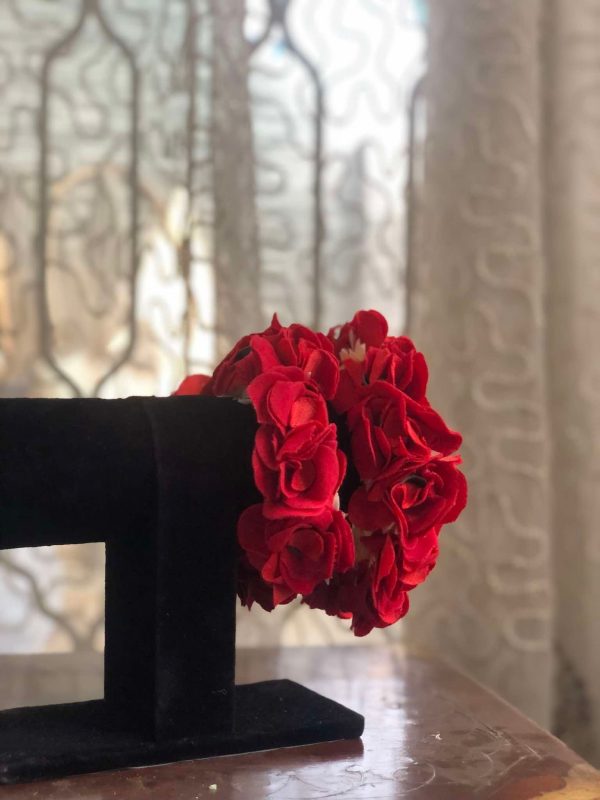In the vibrant world of traditional Pakistani accessories, few items are as beautiful and meaningful as gajray—the delicate, fragrant flower garlands worn during special occasions and celebrations. Gajray have been an essential part of Pakistani culture for centuries, adorning the hair of brides, bridesmaids, and women attending festive gatherings. These beautiful accessories not only carry cultural significance but also enhance the beauty and grace of the wearer. In this blog, we will explore the tradition of creating gajray, with a particular focus on the popular red gajray, their creation, and the role they play in cultural events.

What is a Gajray?
A gajray is a traditional floral accessory that consists of a garland made from fresh flowers. Worn around the hair, wrists, or even neck, gajray have a delicate and enchanting quality that makes them a timeless addition to any celebration. These garlands are often crafted from various flowers such as roses, marigolds, jasmine, and other fragrant blossoms, each of which holds a special significance.
The word “gajray” is derived from the Persian word “gajra,” which means a garland of flowers. In Pakistan, these garlands are used predominantly during weddings, religious ceremonies, festivals, and other joyous events.
The Significance of Red Gajray
Among the many variations of gajray, the red gajray holds a particularly revered place in Pakistani tradition. Red is a color of love, passion, and celebration, and as such, it plays a central role in many wedding ceremonies and other special occasions.
For brides, red gajray symbolize prosperity, happiness, and the beginning of a new chapter. It is often worn during the bridal entry, highlighting the bride’s beauty and elegance. Additionally, red gajray are frequently used during the mehndi (henna ceremony), which marks the beginning of the wedding celebrations.
The red gajray’s bright, bold color also signifies good luck and fortune, making it an essential accessory for various cultural events. The fragrance of the flowers and the vibrancy of the color combine to create a striking aesthetic that connects the wearer to their cultural roots.
The Process of Making Gajray
Creating gajray is an art form that requires patience, skill, and a deep understanding of flowers and their arrangement. Here’s a glimpse into how these beautiful accessories are made:
- Selecting the Flowers: The first step in crafting gajray is selecting the right flowers. Depending on the occasion, different flowers are chosen. For red gajray, red roses, marigolds, or hibiscus are popular choices. These flowers are selected for their rich color, fragrance, and ability to hold up well over time.
- Preparing the Flowers: Fresh flowers are carefully plucked and prepared for the garland-making process. The stems of the flowers are trimmed, and the petals are checked to ensure they’re in perfect condition. For red gajray, special attention is paid to the hue and size of the flowers to ensure uniformity.
- Stringing the Flowers: The flowers are strung together using a strong, yet delicate thread. The arrangement is crucial in ensuring the garland has a balanced and pleasing look. Skilled artisans alternate the flowers to create a harmonious pattern and ensure that the flowers are securely attached.
- Creating the Design: The design of the gajray is typically influenced by the event or the preferences of the wearer. Some gajray feature a single type of flower, while others combine various flowers for a layered effect. In the case of red gajray, a simple but stunning design of alternating red roses and marigolds is a classic choice.
- Finishing Touches: Once the flowers are strung, the gajray is finished off with decorative elements, such as small beads, leaves, or intricate embellishments. These details not only add to the beauty of the gajray but also ensure that it stays intact throughout the day or event.
- Preserving Freshness: Since gajray are made with fresh flowers, they must be kept cool and hydrated to maintain their appearance and fragrance. They are typically kept in a cool place until they are ready to be worn.
Gajray in Modern Times
While the traditional method of creating gajray is still widely practiced, modern-day flower artisans have started to experiment with different techniques and flower combinations to create innovative gajray designs. Artificial gajray, which are crafted using silk or other synthetic materials, are also becoming more popular, especially for people who want a long-lasting piece for keepsakes.
In addition to weddings, gajray have expanded into various other celebrations. They can be seen at birthday parties, cultural festivals, Eid celebrations, and even intimate gatherings, where they bring a sense of festivity and cultural pride.
Why Gajray are So Special
There is something magical about wearing a gajray. Whether you are the bride, a guest at a wedding, or simply attending a family event, a gajray enhances your appearance and fills the air with the sweet scent of fresh flowers. It is not just an accessory, but a connection to one’s heritage and the joy of celebrating life’s most precious moments.
Moreover, the tradition of creating gajray is passed down from generation to generation. In many families, the art of flower garland making is learned at an early age, ensuring that this practice continues for years to come. Gajray symbolize the strength and beauty of tradition, while also reflecting the timeless elegance of Pakistani culture.
Conclusion
The tradition of creating gajray—especially red gajray—continues to thrive as one of the most cherished parts of Pakistani culture. From weddings to festivals, these flower garlands are more than just accessories; they are symbols of love, celebration, and cultural heritage. If you’re looking to add a touch of tradition and beauty to your next special event, a gajray is the perfect accessory to make it even more memorable. Whether you’re wearing one or gifting it, the art of gajray-making is a reminder of the beauty that lies in our rich cultural practices.
Are you ready to adorn yourself with the beauty of a red gajray at your next event? Let’s keep the tradition alive, one flower at a time.
